初中介词讲解及练习题
- 格式:doc
- 大小:71.00 KB
- 文档页数:26
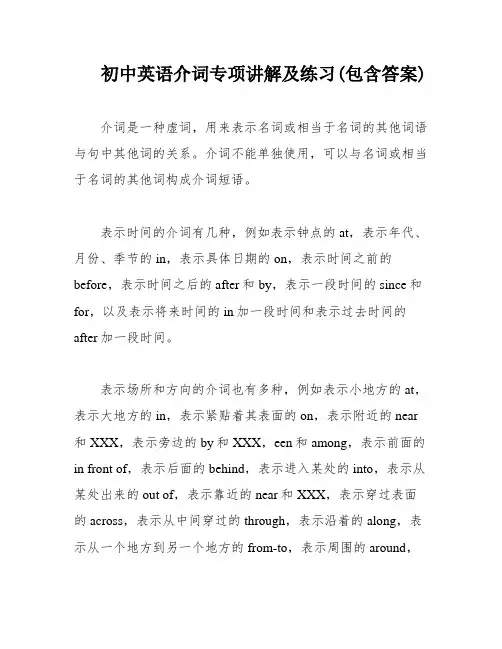
初中英语介词专项讲解及练习(包含答案)介词是一种虚词,用来表示名词或相当于名词的其他词语与句中其他词的关系。
介词不能单独使用,可以与名词或相当于名词的其他词构成介词短语。
表示时间的介词有几种,例如表示钟点的at,表示年代、月份、季节的in,表示具体日期的on,表示时间之前的before,表示时间之后的after和by,表示一段时间的since和for,以及表示将来时间的in加一段时间和表示过去时间的after加一段时间。
表示场所和方向的介词也有多种,例如表示小地方的at,表示大地方的in,表示紧贴着其表面的on,表示附近的near和XXX,表示旁边的by和XXX,een和among,表示前面的in front of,表示后面的behind,表示进入某处的into,表示从某处出来的out of,表示靠近的near和XXX,表示穿过表面的across,表示从中间穿过的through,表示沿着的along,表示从一个地方到另一个地方的from-to,表示周围的around,表示正上方的over,表示正下方的under,表示斜上方的above,表示斜下方的below。
介词的使用需要根据具体情况来判断,掌握介词的用法可以帮助我们更准确地表达自己的意思。
In using a language。
it'XXX to know about the culture and customs of the people you are XXX my experience。
as someone who has lived in different countries。
it's important to adapt and be respectful。
just like you would in your own country.With the right clothing and knowledge。
you can XXX。
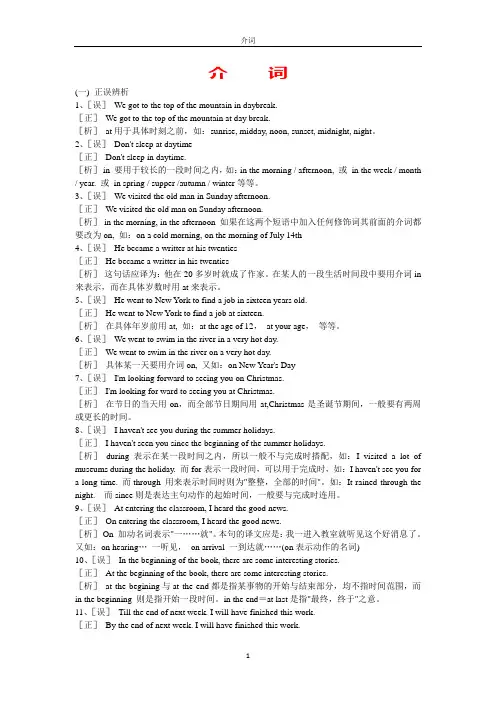
介词(一) 正误辨析1、[误]We got to the top of the mountain in daybreak.[正]We got to the top of the mountain at day break.[析]at用于具体时刻之前,如:sunrise, midday, noon, sunset, midnight, night。
2、[误]Don't sleep at daytime[正]Don't sleep in daytime.[析]in 要用于较长的一段时间之内,如:in the morning / afternoon, 或in the week / month / year. 或in spring / supper /autumn / winter等等。
3、[误]We visited the old man in Sunday afternoon.[正]We visited the old man on Sunday afternoon.[析]in the morning, in the afternoon 如果在这两个短语中加入任何修饰词其前面的介词都要改为on, 如:on a cold morning, on the morning of July 14th4、[误]He became a writter at his twenties[正]He became a writter in his twenties[析]这句话应译为:他在20多岁时就成了作家。
在某人的一段生活时间段中要用介词in 来表示,而在具体岁数时用at来表示。
5、[误]He went to New Y ork to find a job in sixteen years old.[正]He went to New Y ork to find a job at sixteen.[析]在具体年岁前用at, 如:at the age of 12,at your age,等等。

【初中英语】介词专项练习题及答案详解一、初中英语介词1.The Dragon Boat Festival falls_________ May or June every year.A. inB. onC. atD. between【答案】A【解析】【分析】句意:端午节每年五月或六月举行。
May or June五月或六月,月份前需用介词in,故选A。
【点评】考查时间介词辨析,注意in,on,at的用法。
2.The People's Republic of China was founded ________ October 1st, 1949. We'll celebrate its 70th anniversary this year.A. inB. onC. at【答案】 B【解析】【分析】句意:中华人民共和国成立于1949年10月1日。
今年我们要庆祝它70周年。
A.in在,用在世纪、年、季节、月、周等前;B.on在,用于星期几和具体的日期等前;C.at在,用于表示时刻前。
根据句子中 October 1st, 1949,表示具体的日期,要用介词on。
【点评】考查介词辨析。
根据句子的语法结构选择正确的介词。
3.Humans can not make progress dreams.A. withB. withoutC. throughD. about【答案】 B【解析】【分析】句意:没有了梦想,人类就不会进步。
A.带着,有;B.没有;C.通过;D.关于。
梦想是人类前进的动力,根据Humans can not make progress,可知人类不会进步,是因为没有梦想,应会使用介词without,故答案是B。
【点评】考查近词辨析,注意识记介词without的用法。
4. , I found the job boring, but soon I got used to it.A. To start withB. First of allC. Without doubtD. After all【答案】 A【解析】【分析】句意:起初我觉得工作很无聊,但是我很快就适应了。
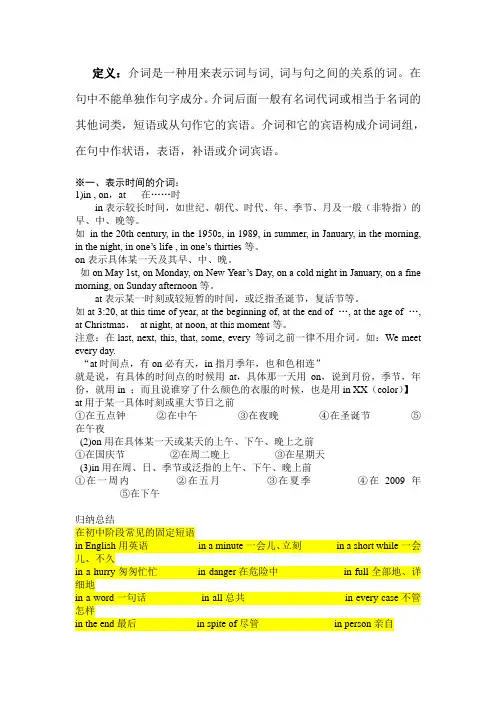
定义:介词是一种用来表示词与词, 词与句之间的关系的词。
在句中不能单独作句字成分。
介词后面一般有名词代词或相当于名词的其他词类,短语或从句作它的宾语。
介词和它的宾语构成介词词组,在句中作状语,表语,补语或介词宾语。
※一、表示时间的介词:1)in , on,at 在……时in表示较长时间,如世纪、朝代、时代、年、季节、月及一般(非特指)的早、中、晚等。
如in the 20th century, in the 1950s, in 1989, in summer, in January, in the morning, in the night, in one’s life , in one’s thirties等。
on表示具体某一天及其早、中、晚。
如on May 1st, on Monday, on New Year’s Day, on a cold night in January, on a fine morning, on Sunday afternoon等。
at表示某一时刻或较短暂的时间,或泛指圣诞节,复活节等。
如at 3:20, at this time of year, at the beginning of, at the end of …, at the age of …, at Christmas,at night, at noon, at this moment等。
注意:在last, next, this, that, some, every 等词之前一律不用介词。
如:We meet every day.“at时间点,有on必有天,in指月季年,也和色相连”就是说,有具体的时间点的时候用at,具体那一天用on,说到月份,季节,年份,就用in ;而且说谁穿了什么颜色的衣服的时候,也是用in XX(color)】at用于某一具体时刻或重大节日之前①在五点钟______②在中午________③在夜晚________④在圣诞节________⑤在午夜_________(2)on用在具体某一天或某天的上午、下午、晚上之前①在国庆节_________②在周二晚上_________③在星期天_________(3)in用在周、日、季节或泛指的上午、下午、晚上前①在一周内_________②在五月_________③在夏季_________④在2009年_________⑤在下午_________归纳总结在初中阶段常见的固定短语in English用英语in a minute一会儿、立刻in a short while一会儿、不久in a hurry匆匆忙忙in danger在危险中in full全部地、详细地in a word一句话in all总共in every case不管怎样in the end最后in spite of尽管in person亲自in fact事实上in good health身体健康的in front of在……前面in some ways在某些方面in common共同的in public当众☆考题再现:---Who was the first man with A(h1n1) flu in mainland China know for sure?---________May 11,2009.A InB OnC ForD Since2、before、afterbefore表示“在某时刻或某件事之前”,after用在时刻或某件事之后。
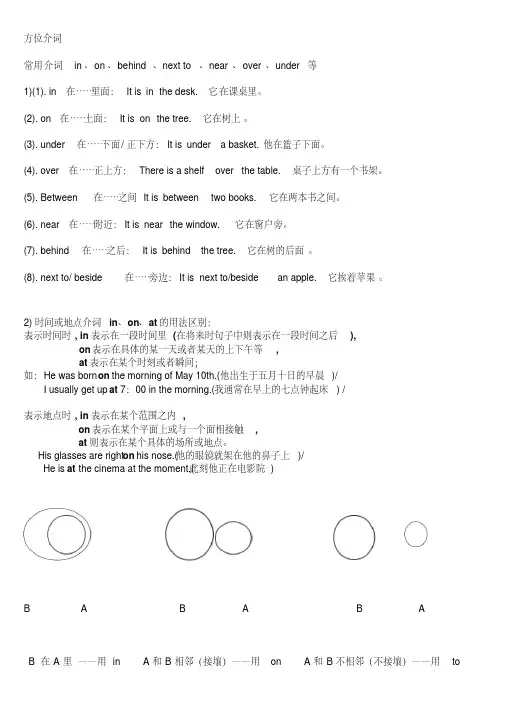
方位介词常用介词in、on、behind、next to、near、over、under等1)(1). in在……里面:It is in the desk.它在课桌里。
(2). on在……上面:It is on the tree.它在树上。
(3). under在……下面/正下方:It is under a basket.他在篮子下面。
(4). over在……正上方:There is a shelf over the table.桌子上方有一个书架。
(5). Between 在……之间It is between two books. 它在两本书之间。
(6). near在……附近:It is near the window. 它在窗户旁。
(7). behind在……之后:It is behind the tree. 它在树的后面。
(8). next to/ beside在……旁边:It is next to/beside an apple. 它挨着苹果。
2)时间或地点介词in、on、at的用法区别:表示时间时, in表示在一段时间里(在将来时句子中则表示在一段时间之后),on表示在具体的某一天或者某天的上下午等,at表示在某个时刻或者瞬间;如:He was born on the morning of May 10th.(他出生于五月十日的早晨)/I usually get up at 7:00 in the morning.(我通常在早上的七点钟起床) /表示地点时, in表示在某个范围之内,on表示在某个平面上或与一个面相接触,at则表示在某个具体的场所或地点。
His glasses are right on his nose.(他的眼镜就架在他的鼻子上)/He is at the cinema at the moment.(此刻他正在电影院)B A B A B AB 在A里——用in A和B相邻(接壤)——用on A和B不相邻(不接壤)——用to。
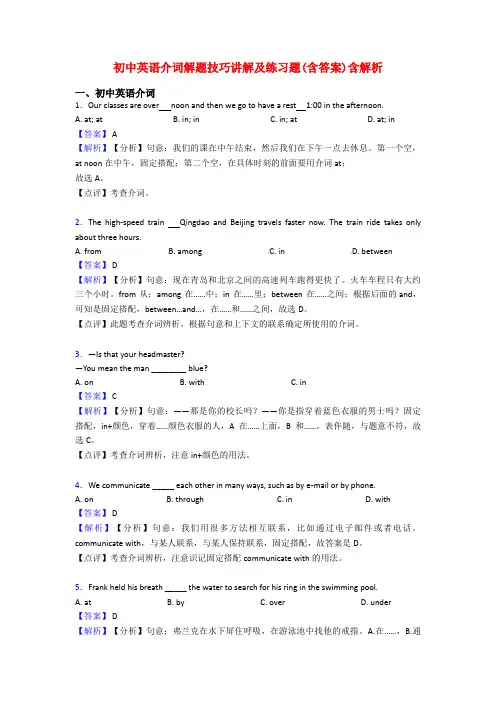
初中英语介词解题技巧讲解及练习题(含答案)含解析一、初中英语介词1.Our classes are over noon and then we go to have a rest 1:00 in the afternoon. A. at; at B. in; in C. in; at D. at; in【答案】 A【解析】【分析】句意:我们的课在中午结束,然后我们在下午一点去休息。
第一个空,at noon在中午,固定搭配;第二个空,在具体时刻的前面要用介词at;故选A。
【点评】考查介词。
2.The high-speed train Qingdao and Beijing travels faster now. The train ride takes only about three hours.A. fromB. amongC. inD. between【答案】 D【解析】【分析】句意:现在青岛和北京之间的高速列车跑得更快了。
火车车程只有大约三个小时。
from 从;among 在……中;in 在……里;between 在……之间;根据后面的and,可知是固定搭配,between…and…,在……和……之间,故选D。
【点评】此题考查介词辨析。
根据句意和上下文的联系确定所使用的介词。
3.—Is that your headmaster?—You mean the man ________ blue?A. onB. withC. in【答案】 C【解析】【分析】句意:——那是你的校长吗?——你是指穿着蓝色衣服的男士吗?固定搭配,in+颜色,穿着……颜色衣服的人,A 在……上面,B 和……,表伴随,与题意不符,故选C。
【点评】考查介词辨析,注意in+颜色的用法。
4.We communicate _____ each other in many ways, such as by e-mail or by phone.A. onB. throughC. inD. with【答案】 D【解析】【分析】句意:我们用很多方法相互联系,比如通过电子邮件或者电话。
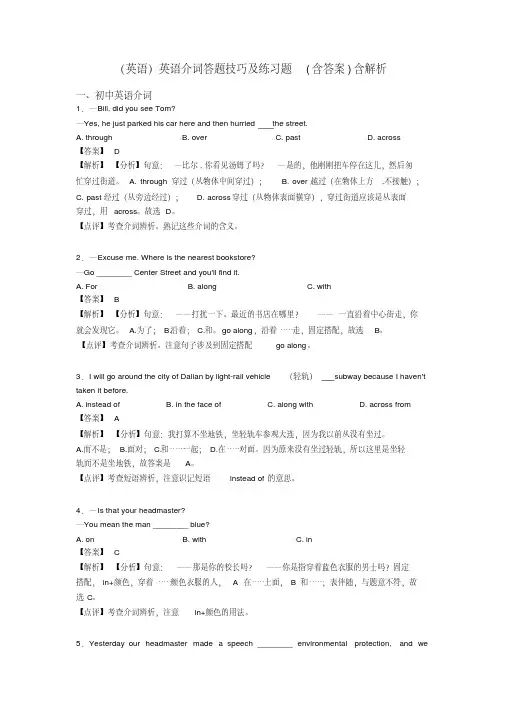
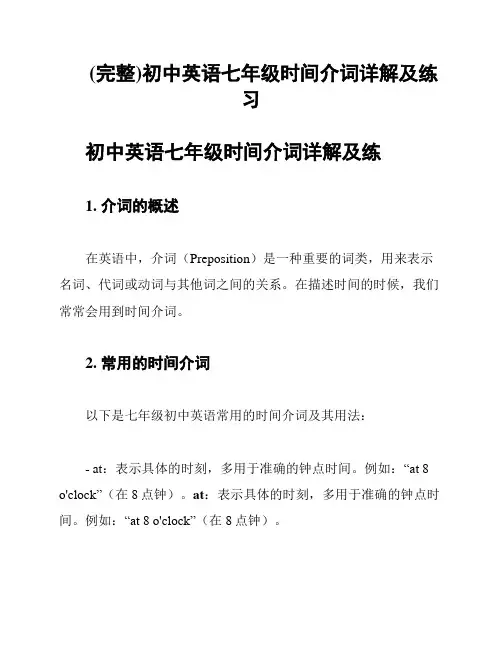
(完整)初中英语七年级时间介词详解及练习初中英语七年级时间介词详解及练1. 介词的概述在英语中,介词(Preposition)是一种重要的词类,用来表示名词、代词或动词与其他词之间的关系。
在描述时间的时候,我们常常会用到时间介词。
2. 常用的时间介词以下是七年级初中英语常用的时间介词及其用法:- at:表示具体的时刻,多用于准确的钟点时间。
例如:“at 8 o'clock”(在8点钟)。
at:表示具体的时刻,多用于准确的钟点时间。
例如:“at 8 o'clock”(在8点钟)。
- on:表示具体的某一天或日期。
例如:“on Monday”(在星期一)。
on:表示具体的某一天或日期。
例如:“on Monday”(在星期一)。
- in:表示较长的时间段,如月份、季节、年份等。
例如:“in July”(在七月)。
in:表示较长的时间段,如月份、季节、年份等。
例如:“in July”(在七月)。
- during:表示某一段时间内发生的事情。
例如:“during the summer vacation”(在暑假期间)。
during:表示某一段时间内发生的事情。
例如:“during the summer vacation”(在暑假期间)。
- for:表示持续的时间。
例如:“for three hours”(持续三个小时)。
for:表示持续的时间。
例如:“for three hours”(持续三个小时)。
练题请根据句意选择适当的时间介词填空:1. I usually go to bed _______ 10 o'clock.2. We have a party _______ Christmas Day.3. They went to the beach _______ their summer vacation.4. Peter studied English _______ three years, and now he speaks it fluently.答案:1. at2. on3. during4. for。
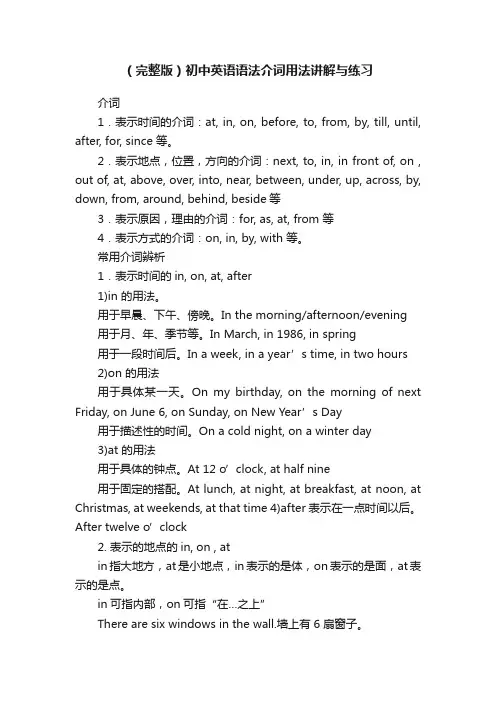
(完整版)初中英语语法介词用法讲解与练习介词1.表示时间的介词:at, in, on, before, to, from, by, till, until, after, for, since 等。
2.表示地点,位置,方向的介词:next, to, in, in front of, on , out of, at, above, over, into, near, between, under, up, across, by, down, from, around, behind, beside等3.表示原因,理由的介词:for, as, at, from 等4.表示方式的介词:on, in, by, with 等。
常用介词辨析1.表示时间的in, on, at, after1)in 的用法。
用于早晨、下午、傍晚。
In the morning/afternoon/evening用于月、年、季节等。
In March, in 1986, in spring用于一段时间后。
In a week, in a year’s time, in two hours2)on 的用法用于具体某一天。
On my birthday, on the morning of next Friday, on June 6, on Sunday, on New Year’s Day用于描述性的时间。
On a cold night, on a winter day3)at 的用法用于具体的钟点。
At 12 o’clock, at half nine用于固定的搭配。
At lunch, at night, at breakfast, at noon, at Christmas, at weekends, at that time 4)after 表示在一点时间以后。
After twelve o’clock2. 表示的地点的in, on , atin指大地方,at是小地点,in表示的是体,on表示的是面,at表示的是点。
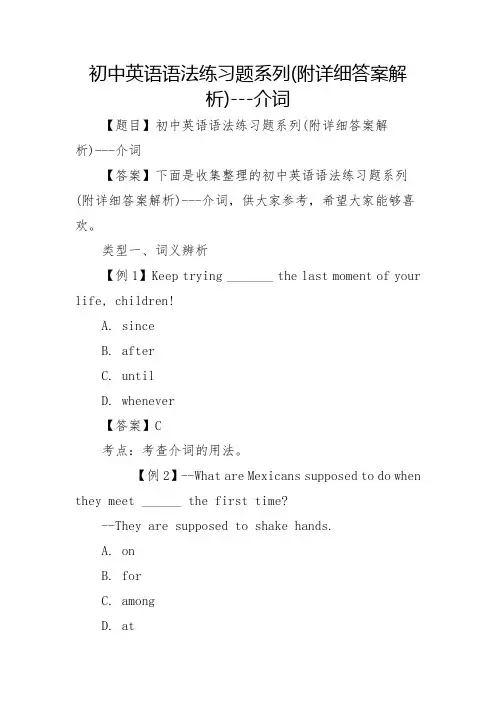
初中英语语法练习题系列(附详细答案解析)---介词【题目】初中英语语法练习题系列(附详细答案解析)---介词【答案】下面是收集整理的初中英语语法练习题系列(附详细答案解析)---介词,供大家参考,希望大家能够喜欢。
类型一、词义辨析【例1】Keep trying _______ the last moment of your life, children!A. sinceB. afterC. untilD. whenever【答案】C考点:考查介词的用法。
【例2】--What are Mexicans supposed to do when they meet ______ the first time?--They are supposed to shake hands.A. onB. forC. amongD. at【答案】B【解析】试题分析:句意:-- 当墨西哥人第一次见面时候,他们应该做什么?--他们应该握手。
分析选项:on在……之上;for对于;among两者之间;at在。
分析:对于第一次见面,因此用介词for.故选B考点:考查介词的用法。
【点睛】词义辨析是介词考查的一个重点,英语中存在着大量的基础介词,如:in、on、at三个介词的区分。
掌握这些介词的用法特点是需要介词的一个关键。
学习中要注意多总结,牢记一些常用介词的词义及用法区别。
类型二、固定搭配【例3】The postcard often reminds me _______ my good friend.A.ofB.forC.atD.with【答案】A【解析】试题分析:句意:这张明信片经常使我想起我的好朋友。
remind sb of sth/sb“使某人想起某事/某人”,故选A。
考点:考查介词的用法。
【点睛】英语介词的一个特点是一词多义,并且介词间语义交叉现象很多,习惯用法也很多,有时很难从词义上区分开来。
故学习中要注意不断总结,熟记一些介词和动词的固定搭配用法及习惯用法,是完成此类问题的捷径。
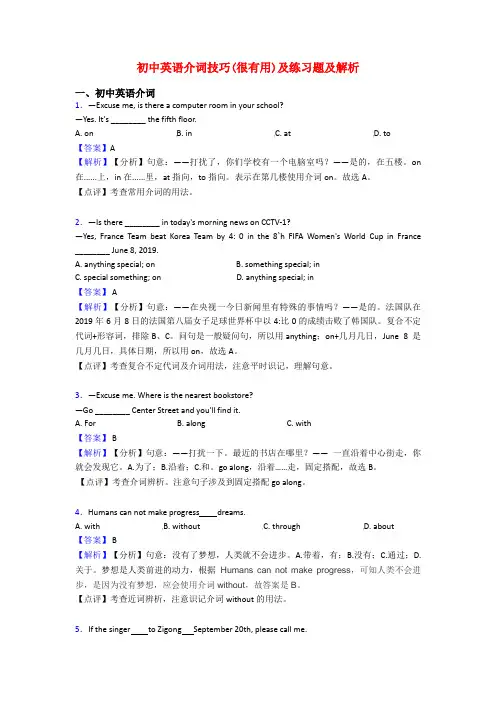
初中英语介词技巧(很有用)及练习题及解析一、初中英语介词1.—Excuse me, is there a computer room in your school?—Yes. It's ________ the fifth floor.A. onB. inC. atD. to【答案】A【解析】【分析】句意:——打扰了,你们学校有一个电脑室吗?——是的,在五楼。
on 在......上,in在......里,at指向,to指向。
表示在第几楼使用介词on。
故选A。
【点评】考查常用介词的用法。
2.—Is there ________ in today's morning news on CCTV-1?—Yes, France Team beat Korea Team by 4: 0 in the 8`h FIFA Women's World Cup in France ________ June 8, 2019.A. anything special; onB. something special; inC. special something; onD. anything special; in【答案】 A【解析】【分析】句意:——在央视一今日新闻里有特殊的事情吗?——是的。
法国队在2019年6月8日的法国第八届女子足球世界杯中以4:比0的成绩击败了韩国队。
复合不定代词+形容词,排除B、C。
问句是一般疑问句,所以用anything;on+几月几日,June 8 是几月几日,具体日期,所以用on,故选A。
【点评】考查复合不定代词及介词用法,注意平时识记,理解句意。
3.—Excuse me. Where is the nearest bookstore?—Go ________ Center Street and you'll find it.A. ForB. alongC. with【答案】 B【解析】【分析】句意:——打扰一下。
初中英语语法基础介词专题讲解一.介词at/ in /on .1.表示时间:1).表示某一具体时间点,某一时刻/ 年龄at six o’clock at noon at that timeat the moment at the age of at night2)in表示时间段,一天的三个时间段以及月份,年,季节,世纪,人生的某个时期(某人几十岁时)in the morning/afternoon /eveningin spring /in 2007/in Marchin the twenty-first centuryin his fifties3)on表示星期几/某一具体的日子/具体某天的上午/下午/晚上,表示一天中的三个时间段名词前有修饰语或后有修饰语时.On Monday on New Year’s Dayon Sunday morning on a rainy nighton the evening of April 1st ,20072表地点:1)at 一般指较小的地点或较具体的位置at the station at the cinema2)in 表示在较大的地点或一个有限空间里.in China in the classroom3)on 指在某物体的表面上.on the desk注意:写街道时,若有门牌号用at ,否则用on / in 都可.He lives at 270 DongChang’an Street.二.介词in /on / to 表方位:1.in表示A地在B地范围之内.(包含关系)Tanwan is ____ the southeast of China .2.on表示A,B地接壤.(外切关系)Hubei is ____ the north of Hunan .3.to表示A,B两地有一定的间距.(外离关系)Japan is _____ the east of China .三. between / among 在……之间1.between :指两者之间. 在…….之间.2.among :用于三者或三者以上人或物之间. 在……之中.You sit _____ him and me .The song is popular ______ the students.四.after / in 在……之后 before / in 在……之前1. after1)after + 时间段. 表示以过去某一时刻为起点的一段时间之后, 用于过去时.2)after 作介词. after doing sth.2.in +一段时间. 表示说话时或以现在为起点的将来一段时间之后.用于将来时.He came back ______ two days .He will go home___finishing his homework .He will come back _____ two days .3. before 多用于时间点或一件事之前发生,即“先于……;在……之前”He left the office bofore I got there. I’ll be back before five o’clock.4. ago 时间段+ ago 表示“多久之前”时态通常用:一般过去时I met Tom two days ago.五.with / in / by 表示“用……”1.with 表示“用…” 一般指有形的工具/ 手段/ 人体器官.He cut the apple into halves ____ a knife .注: with 表伴随, “带有,含有”He came in _____ a big smile on his face .2.in表示用某种语言,方式,途径. 或书写/绘画所用的材料. 也可表交通方式.Can you say it _____English ?He wrote a letter ____ blue ink .3.by表示乘坐交通工具, 表示方式,方法I study for a test _____ working with a group .He makes a living ____ selling newspapers .注意: 同义词组1).by phone = on the phone2).by car = in a car3).in pen = with a pen = with pens六.across / through / over / by 经过1.across 指横穿,穿过. 表示动作从某一物体表面上经过.2.through 指穿过,透过,表示从某一物体空间内通过.3.over 表示从某人或某物的上空经过或越过,不与表面接触.4.by 表示从某人/某物的旁边经过.Can you swim ______ the river ?the elephant is so big that it can’t go _____ the gate .I don’t think anyone can jump ___ the fenc e.I walked _____ the bank of China yesterday .七.in front of / in the front of1.in the front of 表示在…….内部的前面2.in front of 表示在……外面的前面There is a desk in _____ front of our classroom .There is a big tree in _____ front of our classroom.八.其它介词的用法:1.at的其它用法.1).表示“从事或正在做某事”,其后加的名词往往不加冠词.She is at work now = She is working now .2)at表示“价格或速度”The train ran at 120 kilometers an hour .2.in的其它用法:1)in表示“在……方面”词组:do well in = be good atbe weak in2)in 表示“穿着”后接表颜色的词或衣服.词组: be in +衣服= be wearing +衣服3)in作副词, “在家” = at home3.like 的用法:1).像/和……一样. 常与系动词连用.词组: look like sound like2).与what 连用, “是什么样子, 怎样”.What is he like ? He is kind .4.off的用法:1).从……下来, 脱离某物体.词组: fall off2). “休假”通常放在时间名词之后.词组: have +时间+ offHe has n’t had a night off for two hours .5.except / besides1).except 除了…….之外, 都……. . 不包括在范围之内.注: nothing but … 除了……之外,什么也没有.2).besides除了……之外,还有…… . 包括在范围之内.We all went swimming ______ Lucy .There is _______ a letter in the box .We study Japanese and French____ English .6.with / without1).with具有,含有反义词: without 没有词组: with the help of = with one’s help =because of = thanks towithout one’s help2).without 的用法:A).without + sb./ sth. 没有某人或某物B).without + doing sth . He lef t here without____(say ) “Goodbye”to usC). without sth 常与if 引导的否定的条件句.If there is no water , we can’t live .= We can’t live ______ _______ .7.on the tree /in the treeon the tree 表示“树上本身长的东西” 在树上.in the tree 表示“外界的物体进入树中” 人或物在树上.There are some apples _____ the tree .There is a boy ____ the tree.8.表示“数量的介词”about , round around , over1). about , round around表示“大约……”2).over 表示“超过”= more than.9.inside / outsideInside 在……里面------反义词:outside在….外面10.in the wall /on the wallin the wall 表示“门窗在墙上” on the wall 表示“某东西张贴或挂在墙上”九.不用介词的情况:1).当时间状语为: tonight, today, yesterday, tomorrow 等时,不用介词. What are you going to do tonight ?2).含有this, that, these, those, last, next, every/each day等时间状语.He went to Wuhan last week . I drink milk every day.3).以all 开头的时间状语前面不用介词.He has worked all day .4).以some ,any, one 等构成的时间状语前不用介词.He met a bad man one cold morning. = He met a bad man on a cold morning.介词专题小测:一、单项选择题。
英语介词解题技巧(超强)及练习题(含答案)及解析一、初中英语介词1.Don't stay inside such a sunny morning. Let's go out to enjoy the gentle wind and the sweet flowers.A. onB. inC. fromD. at【答案】A【解析】【分析】句意:不要在这样一个阳光明媚的早晨呆在家里。
让我们一起去享受温柔的风和甜蜜的花朵。
A. on 用在某一天,或某一天的早晨,下午、晚上的前面;B. in用在某年,某月,或季节的前面;C. from从,来自;D. at用在表示点钟的时刻前面。
此句中的morning前有形容词sunny来修饰,特指这样的一个上午,前面要用介词on,故选A。
【点评】考查介词辨析。
熟记不同的时间前面的介词用法。
2.The high-speed train Qingdao and Beijing travels faster now. The train ride takes only about three hours.A. fromB. amongC. inD. between【答案】 D【解析】【分析】句意:现在青岛和北京之间的高速列车跑得更快了。
火车车程只有大约三个小时。
from 从;among 在……中;in 在……里;between 在……之间;根据后面的and,可知是固定搭配,between…and…,在……和……之间,故选D。
【点评】此题考查介词辨析。
根据句意和上下文的联系确定所使用的介词。
3.—Thanks to our government, we can have a new library next week.—That's great! And we will read books there ________ a month.A. beforeB. inC. byD. until【答案】 B【解析】【分析】句意:——多亏了政府,下一周我们能够拥有一个新的图书馆。
介词及介词短语【考点直击】1.常用介词及其词组的主要用法及意义2.介词表示时间、方位、方式别的基本用法3.一些易混介词的辨析【语法讲解】◆介词的功能介词是一种虚词,用来表示名词或相当于名词的其它词语句中其它词的关系,不能单独使用。
介词可与名词或相当于名词的其它词构成介词短语.介词短语可在句中作定语,状语,表语和宾语补足语。
例如:The boy over there is John’s brother。
(定语)The girl will be back in two hours. (状语)◆介词和种类(1)简单介词,常用的有at, in, on, about, across,before,beside, for , to, without 等。
(2)复合介词,如by means of, along with,because of, in front of, instead of等.◆不同介词的用法(1)表时间的介词1)at,in on表示时间点用at.例如:at six o’clock, at noon, at midnight。
表示在某个世纪,某年,某月,某个季节以及早晨,上午,下午,晚上时,用in.例如:in the nineteenth century, in 2002, in may, in winter, in the morning,in the afternoon等。
表示具体的某一天和某一天的上午,下午,晚上时,用on。
例如:on Monday, on July 1st, on Sunday morning等。
2)since,after由since和after 引导的词组都可表示从过去某一点开始的时段,但since词组表示的时段一直延续到说话的时刻,因而往往要与现在完成时连用。
而after词组所表示的时段纯系过去,因而要与一般过去时连用。
例如:I haven’t heard from him since last summer.After five days the boy came back。
初中英语介词解题技巧解说及练习题 ( 含答案 ) 含解析一、初中英语介词1.Our classes are over A. at; at noon and then we go to have a restB. in; inC. in; at1:00 in the afternoon.D. at; in【答案】A【解析】【解析】句意:我的在正午束,此后我在下午一点去休息。
第一个空,at noon在正午,固定搭配;第二个空,在详尽刻的前方要用介at;故A。
【点】考介。
2.The high-speed train Qingdao and Beijing travels faster now. The train ride takes only about three hours.A. fromB. amongC. inD. between【答案】D【解析】【解析】句意:在青和北京之的高速列跑得更快了。
火程只有大三个小。
from 从; among 在⋯⋯中; in 在⋯⋯里; between 在⋯⋯之;依据后边的可知是固定搭配,between⋯and⋯,在⋯⋯和⋯⋯之,故D。
【点】此考介辨析。
依据句意和上下文的系确立所使用的介。
and,3.—Is that your headmaster?—You mean the man ________ blue?A. onB. withC. in【答案】C【解析】【解析】句意:——那是你的校?——你是指穿着色衣服的男士?固定搭配, in+色,穿着⋯⋯色衣服的人, A 在⋯⋯上边, B 和⋯⋯,表陪伴,与意不符,故C。
【点】考介辨析,注意in+色的用法。
4.We communicate _____ each other in many ways, such as by e-mail or by phone.A. onB. throughC. inD.with【答案】D【解析】【解析】句意:我用很多方法相互系,比方通子件也许。
初中英语介词答题技巧及练习题(含答案)含解析一、初中英语介词1.We will have Dragon Boat Festival _____June this year.A. inB. onC. atD. of【答案】 A【解析】【分析】句意:今年的端午节在六月份。
A:in在,后接世纪、年、月、星期等;B:on后接星期几(上/下午/晚上)和具体的日期;C:at后接某一时刻;D:of……的。
空格后有June,六月份,要用介词in,故选A。
【点评】考查介词辨析。
理解介词词义和用法,根据句子结构选择正确的介词。
2.—Do you have this T-shirt in a different color?—I'm afraid not. It only comes red.A. ofB. inC. for【答案】 B【解析】【分析】句意:——你有不同颜色的这件t恤吗?——恐怕没有。
只有红色。
根据T-shirt in a different color,可知是in+颜色,故选B。
【点评】考查介词辨析,注意辨别介词of、in和for 的用法。
3.—Thanks to our government, we can have a new library next week.—That's great! And we will read books there ________ a month.A. beforeB. inC. byD. until【答案】 B【解析】【分析】句意:——多亏了政府,下一周我们能够拥有一个新的图书馆。
——棒极了!再过一个月我们就可以在那里读书了。
in a month,再过一个月,一般用于一般将来时,故答案是B。
【点评】考查介词辨析,注意在一般将来时中引出时间段使用in。
4.Yesterday our headmaster made a speech ________ environmental protection, and we learned something about recycling of waste.A. onB. atC. to【答案】 A【解析】【分析】句意:昨天我们的校长做了一个关于环境保护的演讲,并且我们学到了一些关于废物利用的知识。
初中英语介词题20套(带答案)含解析一、初中英语介词1.—Excuse me, is there a computer room in your school?—Yes. It's ________ the fifth floor.A. onB. inC. atD. to【答案】A【解析】【分析】句意:——打扰了,你们学校有一个电脑室吗?——是的,在五楼。
on 在......上,in在......里,at指向,to指向。
表示在第几楼使用介词on。
故选A。
【点评】考查常用介词的用法。
2.—Excuse me. Where is the nearest bookstore?—Go ________ Center Street and you'll find it.A. ForB. alongC. with【答案】 B【解析】【分析】句意:——打扰一下。
最近的书店在哪里?——一直沿着中心街走,你就会发现它。
A.为了;B.沿着;C.和。
go along,沿着……走,固定搭配,故选B。
【点评】考查介词辨析。
注意句子涉及到固定搭配go along。
3.Let's take a walk ________ the river after diner, shall we?A. alongB. throughC. uponD. over【答案】 A【解析】【分析】句意:让我们晚饭后沿着河流散步吧,好吗?A.沿着;B.穿过;C.根据;D.在......正上方。
根据常识可知沿着河流散步,along the river,沿着河流,固定搭配,故选A。
【点评】考查介词辨析,注意平时识记其词义,理解句意。
4.—Is that your headmaster?—You mean the man ________ blue?A. onB. withC. in【答案】 C【解析】【分析】句意:——那是你的校长吗?——你是指穿着蓝色衣服的男士吗?固定搭配,in+颜色,穿着……颜色衣服的人,A 在……上面,B 和……,表伴随,与题意不符,故选C。
初中介词讲解及练习题介词讲解课题教学内容知识框架介词一、定义与特征1. 介词又叫前置词,是一种虚词。
2. 介词是一种用来表示词与词,或者词与句之间的关系的词,在句中不能单独作句子成分。
3. 介词一定要有宾语,充当宾语的一般有名词、代词或相当于名词的其它词、短语或句子。
二、介词的分类A 表时间的介词 B表地点位置的介词 C表方式的介词 D其他的介词三、表示方位的介词1. on, inon是指在某物的表面上,与物体表面接触。
其反义词是beneath。
They are sitting on the grass. 他们正坐在草地上。
A lovely cat is lying on the table. 一只可爱的小猫正躺在桌子上。
The little mouse is beneath the paper, so it is not easy to find.这只小老鼠在纸下面,所以不容易被发现。
英语中打击人的头、额、鼻、耳、颈、肩、腿等部位时,用on。
The headmaster patted the boy on the head and comforted him.校长拍拍小男孩的头安慰他。
表示植物本身生长出来的枝叶、花果等用on。
There are a lot of pears on the tree. 树上有许多梨。
in 表示“在……之上”时,暗示占去了某物的一部分,强调接触的深度。
There is/are a hole/two windows in the wall. 墙上有个洞/两扇窗户。
英语中打击人的脸、眼、嘴、胸、腹等部位时,用in。
表示植物本身以外的人或动物“在树上”,用in意指枝叶遮掩其中。
2. over, above, under, belowover强调在物体的正上方。
under强调在物体的正下方,是over的反义词。
The bridge over the river has a long history. 河上的这座桥历史悠久。
We took shelter from the rain under a tree. 我们在树下躲雨。
注意:above还有“覆盖;越过”之意。
The thief climbed over the wall and ran away. 那个贼翻过围墙逃走了。
above强调在物体的上方,但不一定是正上方;还可以指温度,海拔等的刻度。
The plane flew above the clouds. 飞机在云层之上飞行。
The average temperature here in winter is above 3?. 这里冬天的平均温度超过三摄氏度。
The mountain is about 2,000 meters above the sea. 那座山海拔约2,000米。
below强调在下方,但不一定是正下方,可指温度海拔等的刻度,是above的反义词。
I live below the mountain. 我住在山脚下。
3. in, on, to在方位名词前的区别三者都可用来表示两地之间的方位关系。
in表示在某范围之内 Hebei Province is/lies in the east of China.to表示在某范围之外 Shanghai is/lies to the southeast of Hebei Province.on表示“毗邻”“接壤” Japan lies in the east of As ia and to the east of China.4. in, at 二词均可表示“在……处”。
in用于指较大的地方。
He lived in Beijing for 10 years. 他在北京生活了十年。
at用于指较小的地方,如在门牌号码前。
We’ll meet each other at the park. 我们将在公园见面。
5. from, out of 二词均表示来源或出处。
from注重起点,意为“从……”。
The train from London arrives here at 10 o’clock. 从伦敦来的火车10点到这。
out of侧重于从里向外,意为“从……里出来”。
She took the passport out of her handbag and showed it to the policeman.她从包里拿出护照把它交给警察。
We are moving out of our school yard. 我们正从校园出来。
6. between, among 二者均表示“在……中间”、“在……之间”。
between表示在二者之间,有时出现三个或三个以上的“宾语”,但这时强调的仍然是其中每两者之间的相互关系。
The house stands between two farms. 那座房子位于两个农场之间。
Luxemburg lies between France, Germany, and Belgium. 卢森堡位于法国、德国与比利时之间。
among指在三者或三者以上之间。
There is a forest among the hills. 那些小山之间有一片森林。
注意:当句中出现divide, share之类的词时,如果后面跟着几个单数名词,用between。
如果后面是复数名词,between和among都可以。
He divided his money between Mary, John and Helen. 他把钱分给玛丽、约翰和海伦。
7. across, through, past, overacross强调穿过某一平面或横穿狭长物体,宾语常为the square, the bridge, the mountain,the street等。
Be careful while walking across the street. 过街时务必小心。
through强调从某一空间内穿过或沿着狭长的物体移动。
宾语常为the street, the forest, the gate,the valley等。
We walked through the forest. 我们穿过那片森林。
Walk through the gate and you’ll see the rest room. 穿过大门就会看到厕所。
past强调从某事物的一旁经过。
They drove past a big supermarket. 他们开车经过一家大超市。
over强调从一边到另一边或越过某一高度,宾语常为the street, the bridge, the mountain,the square等。
The dog jumped over the fence and ran away. 狗跳过栅栏跑了。
The plane flew over the Great Wall. 飞机飞过长城。
8. in front of, in the front ofin front of表示在某一空间外部的前面。
In front of my home runs a small river. 在我家门前有一条小河。
We planted some trees in front of our house. 我们在房子前面种了一些树。
in the front of表示在某一空间内部的前面。
Don’t sit in the front of the car. 不要坐在小汽车的前部。
9. to, for, toward(s)to用在表示来往行动的动词后,如go, come, walk, run, dash, rush, move, fly, return, lead, take之后,表示行动的方向。
for多用于表示“启程”,“出发”“离开”的动词,如leave, set off,start之后。
to与toward(s)在表示“朝……方向”时,可互换,toward(s)仅表示方向,不表示到达,而to不仅表方向,还表示到达。
It’s difficult to decide which area the plane is flying to. 很难断定飞机要飞往哪个地区。
My sister is leaving for New York early tomorrow morning. 我妹妹明天上午要动身去纽约。
四、表示时间的介词1. inin 表时间段,即指在较长的一段时间内,相当于during。
如世纪、朝代、年代、年、月、季节等。
in Ming Dynasty 在明朝 in the 1980s 在二十世纪八十年代in August 在八月份 in spring/summer/autumn/winter 在春天/夏天/秋天/冬天in the winter holidays 在寒假in one’s life 在某人一生中in the daytime/night 在白天/夜里 in the year 2010 在2010年注意:during 除了具有in表示时间段的功能之外,还可指在某一项活动的过程中。
during the night 在晚上 during the fire 在火灾期间in也可表将来,表示从现在算起的一段时间之后。
in a while 一会儿,立刻I’ll be back in an hour. 我一小时后回来。
2. at at用来表示时刻、时间的一点。
at five o’clock 在五点种 at soon 在中午at也可表示较短暂的一段时间,可用在节日名词或被认为是一年中标志大事的日子。
at daybreak 破晓 at Christmas 在圣诞节3. onon表示在具体的某一天,某一天的上午、下午或晚上,或对某一天或某一天的上午、下午、晚上进行详细描述。
on Monday afternoon 在星期一下午 on that day 在那天on a sunny day in November 在十一月一个晴朗的日子on the following day 在第二天on New Year’s Day 在元旦on the morning of April the first 在四月一日上午 on weekend 在平日(时)=at weekends4. in, after in和after都可表示“……(时间)之后”。
“in + 时间段”用于将来时;He’ll be back in three hours. 他三个小时以内回来。
“after + 时间段”用于过去时。
after后接一个具体的时间点时,也可用于将来时。